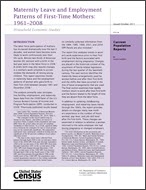Maternity Leave and Employment Patterns of First-Time Mothers: 1961-2008
Maternity Leave and Employment Patterns of First-Time Mothers: 1961-2008
Introduction
The labor force participation of mothers has increased dramatically over the last 3 decades, and women have become more likely to work continuously over their life cycle. Almost two-thirds of American women (62 percent) with a birth in the last year were in the labor force in 2008.1 A child’s birth may also require changes in a mother’s work schedule to accom- modate the demands of raising young children. This report examines trends in maternity leave and the employment patterns of women who gave birth to their first child between January 1961 and December 2008.2
The analysis primarily uses retrospective fertility, employment, and maternity leave data from the 2008 Panel of the U.S. Census Bureau’s Survey of Income and Program Participation (SIPP), conducted in 2008.3 Previously published results based on similarly collected information from the 1984, 1985, 1996, 2001, and 2004 SIPP Panels are also included.4
The report first analyzes trends in women’s work experience prior to their first birth and the factors associated with employment during pregnancy. Changes are placed in the historical context of the enactment of family-related legislation during the last quarter of the twentieth century. The next section identifies the maternity leave arrangements used by women before and after their first birth and the shifts that have occurred in the mix of leave arrangements that are used. The final section examines how rapidly mothers return to work after their first birth and the factors related to the length of time they are absent from the labor force.
In addition to updating childbearing, employment, and maternity leave trends through the 1990s, the report provides details on changes many new mothers experience in the number of hours worked, pay level, and job-skill level after the first birth. These changes are examined in relation to whether a woman returned to the same employer she had during pregnancy or changed employers after the birth of the child. This report also examines how various social and economic factors are related to the timing of new mothers returning to work.
Footnotes
1 Jane Lawler Dye, Fertility of American Women: June 2008, Current Population Reports, P20-563, U.S. Census Bureau, Washington, DC, 2010, Table 3.
2 The estimates in this report (which may be shown in text, figures, and tables) are based on responses from a sample of the population and may differ from the actual values because of sampling variability or other factors. As a result, apparent differ- ences between the estimates for two or more groups may not be statistically significant. All comparative statements have undergone statistical testing and are significant at the 90 percent confidence level unless otherwise noted.
3 The data in this report were collected from January through April 2009 in the second wave (interview) of the 2008 SIPP; from June through September 2004 in the second wave of the 2004 SIPP; from June through September 2001 in the second wave of the 2001 SIPP; from August through November 1996 in the second wave of the 1996 SIPP; from January through April 1986 in the fourth wave of the 1985 SIPP; and from January through March 1986 in the eighth wave of the 1984 SIPP. The population represented (population universe) is the civilian noninstitutionalized population living in the United States.
4 For more information on the previously published reports, see Martin O’Connell, “Maternity Leave Arrangements: 1961–85,” Work and Family Patterns of American Women, Current Population Reports, P23-165, U.S. Census Bureau, Washington, DC, 1990; Kristin Smith, Barbara Downs, and Martin O’Connell, Maternity Leave and Employment Patterns: 1961– 1995, Current Population Reports, P70-79, U.S. Census Bureau, Washington, DC, 2001; Julia Overturf Johnson and Barbara Downs, Maternity Leave and Employment Patterns: 1961–2000, Current Population Reports, P70-103, U.S. Census Bureau, Washington, DC, 2005; Tallese D. Johnson, Maternity Leave and Employment Patterns of First-Time Mothers: 1961–2003, P70-113, U.S. Census Bureau, Washington, DC, 2008.
Source and Accuracy
Survey of Income and Program Participation:
Wave 2
Others in Series
Publication
Publication
Publication







